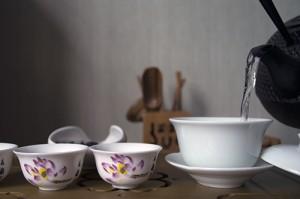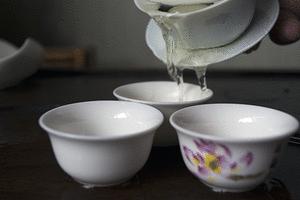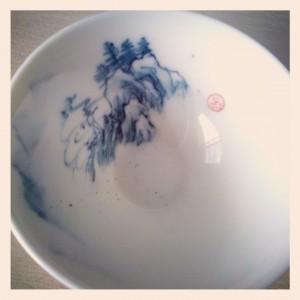In Part I, we looked at whether enjoying oolong tea is indeed different from the rest while in Part II we looked at the essence. In this post, we will look at the ‘how’ of it.
As mentioned many times, gongfu tea is inseparable from proper appreciation of oolong tea.
Weng Hui Dong’s (翁辉东) seminal writing on Chaozhou’s Classics of Tea ( 潮州茶经) has a succinct and informative description of it:
“洒茶既毕,乘热,各人一杯饮之。
杯缘接唇,杯面迎鼻,香味齐到,
一啜而尽,三嗅杯底,味云腴,
食秀美,芳香溢齿颊,甘泽润喉吻”
Translated it reads:
“After distributing the tea, while it’s hot, each person to drink a cup.
The edges of the cup touches the lips, the cup placed below the nose, allow the fragrance to rise,
Sip completely, smell the empty cup thrice, taste the tea,
Feast on the beauty; aroma lingers on the teeth, sweet aftertaste soothes the throat”
“While it’s hot”

From warming the vessel to dousing it with water, eschewing the cha hai and especially the ‘fragrance cups’ (闻香杯), maintaining the heat is of paramount importance.
There are more than 400 chemical compounds in oolong tea that can contribute to the fragrance of it, some can only be dissolved in high heat.
One of clearest illustration of this is the Dancong- try brewing it at near boiling water and 80⁰C and you will realize the natural unique Dancong aroma is only unleashed at high heat. (A mistake I admitted to making)
Hence, the tea should be distributed to the guest while it’s hot for the guest to savor the aroma.
“The cup placed below the nose, allow the fragrance to rise”
Another way of saying this would be “未尝其味先闻其香” which means simply “smell it before you taste it”.
The earlier point suggests 2 things:
i) 400 chemical compounds contribute to the fragrance- in other words, some effort is required to appreciate it
ii) The tea is very hot.
Scientist discovered that people who consumed their tea at 70⁰C and above are 8 times more likely to develop esophageal cancer so there is a very practical reason to do so as well.
Hold the tea below your nose and left the aroma rise to you, as it cools, the aroma changes as well. As mentioned earlier, some of the compounds are unleashed at high temperatures but dissipates as the tea cools.
At this point, other fragrances that were previously obscured would then be more discernible, allowing the tea drinker to enjoy the subtle changes.
“Sip completely”

The word 啜 (chuo) is also used for consumption of soup. Hence it is a slurping type of consumption.
This indicates that the liquor is broth-like and has a rich body.
“Completely” or “to completion” doesn’t mean in one mouthful but in one sitting, 3 mouthfuls to be exact, in certain schools.
Like the aroma, the taste of tea changes subtly with the temperature and as you take in the first cup and allow it to swirl in the mouth slowly, the temperature would drop slightly for the subsequent servings.
In addition, as we are not talking about the Big Gulp Challenge here, a cup that can be consumed in 3 mouthfuls is natural small, usually 50-60 cc.
Why “completely”?
That brings us to the next point.
“Smell the empty cup thrice”
Here “thrice” is not to be taken literally.

Hence you don’t really have to lift it up ritualistically thrice but smell until the fragrance is gone.
Thinner porcelain cups retain the empty cup fragrance (杯底香) and the orchid fragrance of Wuyi Yancha is considered an integral part of the ‘yan yun’ (岩韵) that aficionados value in ‘Zheng Yan’ or core producing area Yancha.
Again this is based on myriad of fragrance contributing compounds in oolong teas and the reduced temperature will allow a pleasant soothing and not overpowering aroma to linger.
“Aroma lingers on the teeth”
When you are done with your cup of oolong tea, don’t rush to refill, tempting as it may be. Take some time to feel the aroma linger on the teeth, suck on the teeth and feel it in the roof of the mouth.
Which brings us to the final point:
“Sweet aftertaste soothes the throat”
This is not unique to oolong tea, the recurring sweetness or ‘huigan’ (回甘) is part of the enjoyment of good tea.
The difference between commodity tea and good tea is how it lingers on the throat. While the former leaves a bitter and astringent feel (or obscured by milk and sugar), the latter leaves a natural sweet smooth soothing aftertaste.
Back to the Essence
In part II we talked about tiny vessels and effort.
In other modern society we are tempted to think bigger is better but the opposite is true for oolong tea.
A pint of Dancong will take forever to cool down and it is hard to savor the changing aroma.
At the same time, volume is actually an impediment to savoring oolong tea to the fullest.
Let me end with an illustration:
We Chinese love our rice. Scarcely a day goes by that we don’t consume rice.
But for most part rice is an accompaniment to other dishes.
In fact for most of us we think as rice as tasteless, often covering it with spoonful of thick gravy.
But it is actually sweet, something I only discovered when my friend told me.
The catch, you have to take one or two grains and chew slowly.
The same applies for oolong tea, chugging by the pint is not going to help you discern the subtleties of it, don’t waste good oolong tea by making it in huge mugs.
See here for more articles related to tea appreciation.
